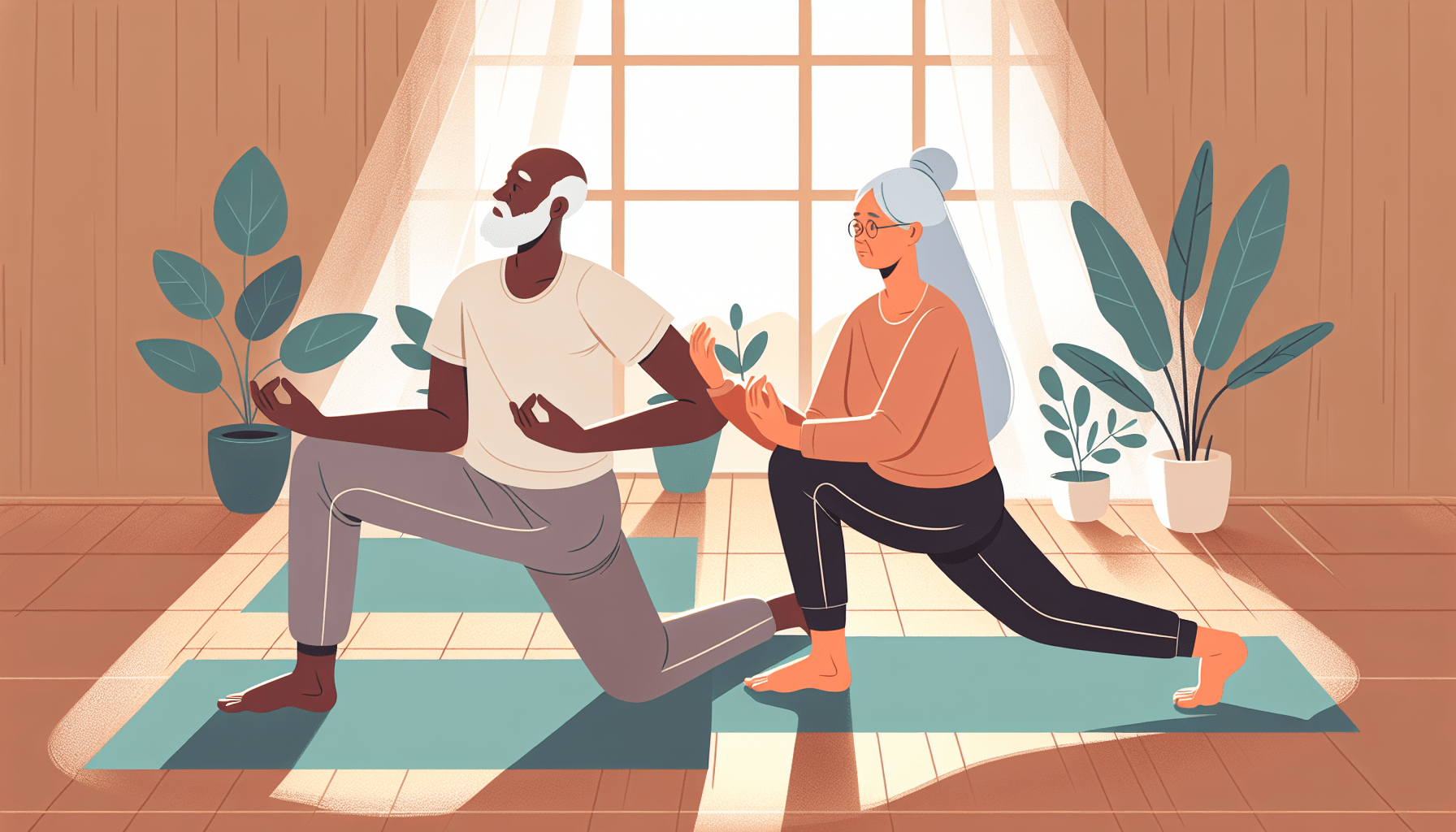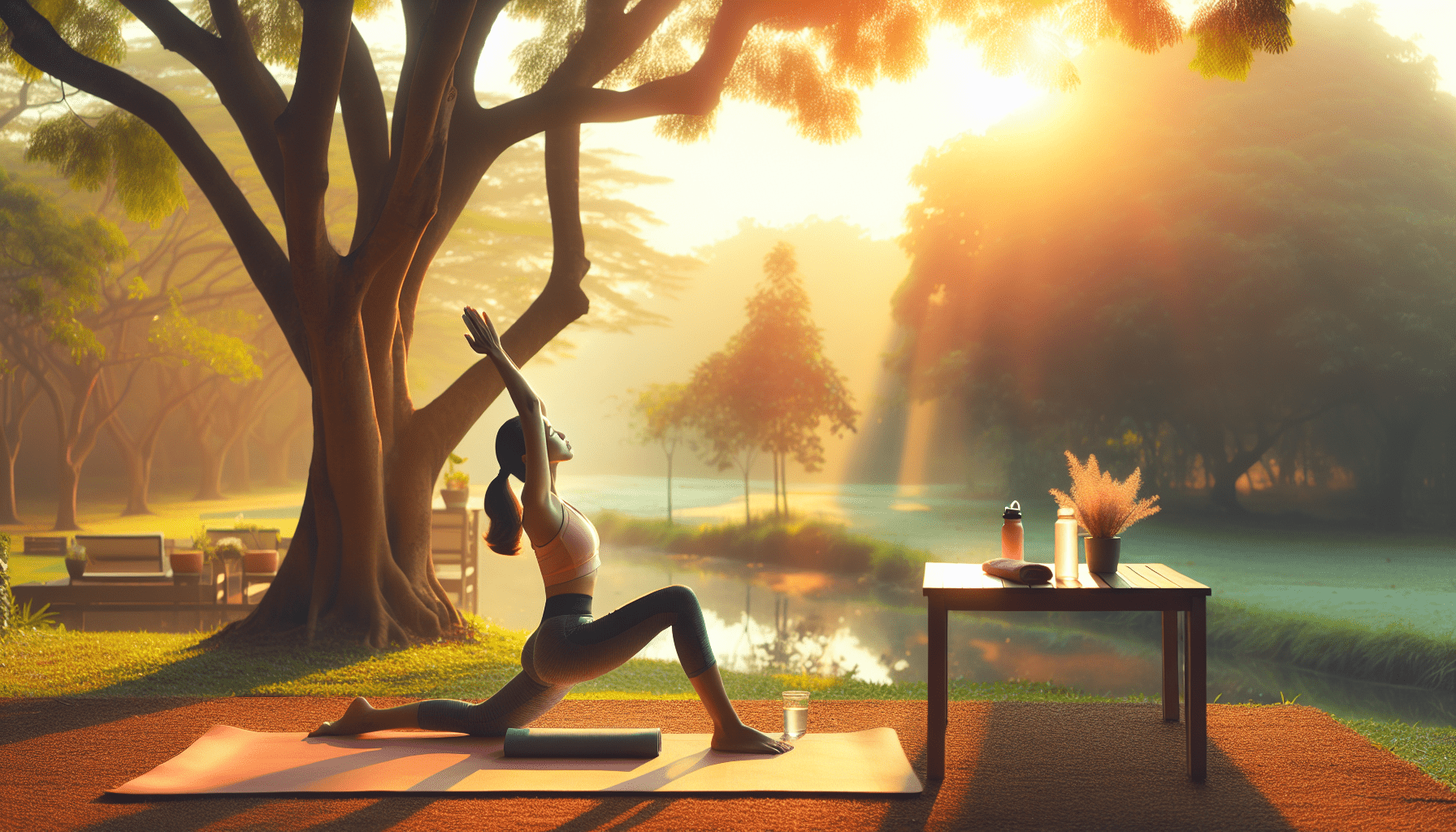Are you looking for a way to improve your flexibility, balance, and overall well-being as a senior? Look no further than “Yoga For Seniors Gentle Stretches.” This article will guide you through a series of gentle stretches specifically designed for older adults, helping you to stay active, relieve stress, and maintain a healthy body and mind. Whether you’re a beginner or have some experience with yoga, these easy-to-follow stretches will provide countless benefits for your physical and mental health. Embrace the calming and rejuvenating practice of yoga, tailored just for you.

Importance of Yoga for Seniors
Yoga has become a popular form of exercise and relaxation for people of all ages, but it holds particular importance for seniors. As we age, our bodies undergo various changes, such as decreased flexibility, balance issues, and joint stiffness. Yoga offers a holistic approach to combat these age-related challenges, providing countless benefits for seniors. By incorporating yoga into your daily routine, you can improve flexibility and balance, reduce stress, enhance joint health, and reduce the risk of injury.
Benefits of Yoga for Seniors
Improved flexibility and balance
One of the most noticeable benefits of practicing yoga for seniors is improved flexibility and balance. Gentle stretches and poses in yoga target different muscle groups, releasing tension and promoting joint mobility. With regular practice, you will find yourself more agile and capable of performing daily activities with ease. Improved balance is also a key benefit of yoga, reducing the risk of falls and maintaining stability as you age.
Stress reduction and improved mental health
Seniors often face various challenges, which can lead to stress and negatively impact mental health. Thankfully, yoga offers a powerful solution in reducing stress and enhancing overall wellbeing. The combination of gentle movements, deep breathing, and mindfulness techniques promotes relaxation and calms the mind. Regular yoga practice can help manage stress, alleviate anxiety and depression, and improve mental clarity and focus.
Enhanced joint health
As we age, joint health becomes a crucial concern for seniors. Yoga poses and stretches gently work on the joints, improving their flexibility, strength, and range of motion. Whether it’s the knees, hips, shoulders, or spine, yoga helps lubricate the joints and reduce stiffness. This increased joint health not only improves mobility but also helps manage chronic conditions such as arthritis.
Reduced risk of injury
Seniors are more susceptible to injuries due to decreased muscle strength and balance issues. Yoga offers a safe and controlled environment to build strength, stability, and body awareness. Through practicing various poses, you can target specific muscle groups, strengthening them and reducing the risk of injuries. Yoga also improves proprioception, the sense of body position and movement, which further aids in preventing accidents.
Choosing the Right Yoga Practice
When it comes to choosing the right yoga practice as a senior, it’s essential to consider your individual needs, abilities, and limitations. Not all yoga styles are suitable for seniors, so finding the one that matches your physical condition and preferences is crucial.
Gentle Yoga vs. More Advanced Styles
Gentle yoga is an excellent starting point for seniors who are new to yoga or have physical limitations. The emphasis is on relaxation, stretching, and slow movements, making it accessible and safe for seniors. As you gain confidence and build strength, you can gradually explore more advanced styles such as Hatha, Iyengar, or Vinyasa. However, it’s crucial to remember that each individual is different, and it’s essential to listen to your body’s needs.
Considerations for Seniors
When choosing a yoga practice, seniors should consider certain factors. Look for classes specifically designed for seniors or individuals with limited mobility. These classes often include modifications and adaptations suitable for aging bodies. Additionally, consider the location of the classes, ensuring they are easily accessible and preferably close to home to encourage regular attendance.
Finding a Qualified Instructor
It is essential to find a qualified yoga instructor who has experience teaching seniors and understands the specific needs and limitations that come with aging bodies. Look for instructors who have completed specialized training in senior yoga or have worked with seniors in the past. A knowledgeable instructor can guide you through the poses, ensure correct alignment, and offer modifications as needed.
Adapting Poses and Movements
As a senior, it’s important to adapt poses and movements to accommodate your abilities and limitations. Many traditional yoga poses can be modified to make them more accessible and comfortable. Always listen to your body and avoid pushing beyond your comfort zone. A qualified instructor can offer guidance and help you modify poses to suit your individual needs.
Modifying for Individual Abilities and Limitations
Every senior has unique abilities and limitations. Tailoring your yoga practice to suit your individual needs is crucial to ensuring a safe and enjoyable experience. If you have any previous injuries or health conditions, it’s important to inform your instructor so they can provide appropriate modifications. Remember, yoga is a personal journey, and it’s okay to modify poses or take breaks when needed.
Warm-Up Exercises
Before diving into the main yoga practice, it’s essential to warm up your body to prevent injuries and prepare your muscles for the stretching that lies ahead. Warm-up exercises help increase blood flow, loosen muscles, and lubricate the joints. Here are a few essential warm-up exercises for seniors:
Joint Mobility Exercises
Start by gently moving each joint in your body, paying attention to areas that tend to be stiff or uncomfortable. Rotate your wrists, ankles, and shoulders. Move your hips and knees in circular motions. Flex and extend your fingers and toes. Performing joint mobility exercises will help increase range of motion and ease into the yoga practice.
Neck and Shoulder Stretches
The neck and shoulders are common areas of tension for many seniors. Perform gentle neck rolls, moving your head slowly in a circular motion, and then reversing the direction. Next, bring your ear towards your shoulder on both sides, holding the stretch for a few seconds. Roll your shoulders backward and forward to release tension and improve mobility.
Wrist and Ankle Rotations
To warm up your wrists, gently rotate them in circular motions, both clockwise and counterclockwise. This will help improve flexibility and reduce stiffness. Similarly, rotate your ankles, alternating between clockwise and counterclockwise rotations. These exercises are particularly beneficial for seniors who may experience joint stiffness due to arthritis or other conditions.
Spine Warm-Up Exercises
The spine is the central pillar of our body, and it’s essential to warm it up before engaging in yoga practice. Start by sitting or standing tall and gently twist your torso from side to side. This will warm up your spine and release any tension or stiffness. You can also perform gentle cat-cow stretches, alternating between arching and rounding your back, to further loosen up the spine.

Seated Stretches
For seniors who prefer or need to perform yoga in a seated position, there are numerous stretches that can be done comfortably. Seated stretches are an excellent option for individuals with limited mobility or balance issues.
Spinal Twist
Begin by sitting tall in a chair, facing forward. Place your right hand on the outside of your left thigh and gently twist your torso to the left. Use your left hand on the back of the chair for support. Hold the twist for a few breaths, feeling the gentle stretch along your spine. Release the twist and repeat on the other side.
Side Bends
While seated, reach your right arm overhead, lengthening your spine. Slowly lean to the left, feeling the stretch along the right side of your body. Hold the stretch for a few breaths, then return to an upright position. Repeat on the other side.
Neck Stretches
To release tension in your neck, sit tall and gently drop your right ear towards your right shoulder. Avoid lifting your shoulder towards your ear. Hold the stretch for a few breaths, then repeat on the other side. You can also perform gentle neck rotations, slowly moving your chin towards your chest, then to the right shoulder, back, and left shoulder, completing the circle.
Forward Bends
Sitting with your feet flat on the floor, slowly hinge forward from your hips, reaching towards your toes. If you can’t reach your toes, place your hands on your shins or thighs. Remember to keep your back straight and avoid rounding your spine. Hold the stretch for a few breaths, feeling the gentle stretch along the back of your legs and lower back.
Hip Stretches
While seated, cross your right ankle over your left knee, creating a figure four shape with your legs. Gently press down on your right knee to deepen the stretch in your right hip. Hold the stretch for a few breaths, then repeat on the other side. This stretch is particularly beneficial for seniors who experience tightness or discomfort in the hips.
Standing Stretches
For seniors with a higher level of mobility, standing stretches offer an opportunity to engage more muscle groups and increase overall strength and flexibility.
Mountain Pose
Stand tall with your feet hip-width apart and relaxed. Ground your feet into the floor, evenly distributing weight between both feet. Roll your shoulders back and down, allowing your arms to hang naturally by your sides. Engage your core muscles and lift the crown of your head towards the ceiling. Take a few deep breaths in this calming and grounding position.
Leg and Hip Stretches
To stretch your legs and hips, stand near a wall or use the back of a sturdy chair for support. Lift your right heel towards your glute, reaching back with your right hand to grab your ankle. Gently pull your heel towards your glute, feeling the stretch in your quadriceps. Hold for a few breaths, then release. Repeat on the other side.
Calf Stretches
Stand facing a wall or chair, extending your arms for support. Step your right foot back, keeping it flat on the ground, and bend your left knee. Lean forward slightly, feeling the stretch in your right calf. Hold for a few breaths, then switch sides. This stretch is particularly beneficial for seniors who experience tightness or cramping in their calf muscles.
Balance Exercises
Improving balance is crucial for seniors to prevent falls and maintain stability. Standing on one leg and engaging your core muscles can help enhance balance and proprioception. Stand tall and lift your right foot off the ground, placing the sole against your left ankle or calf. Find a focal point to gaze at, and slowly extend your arms out to the sides for balance. Hold the pose for a few breaths, then switch legs.
Supported Poses
For seniors who require additional support during their yoga practice, various modifications and props can be used to ensure safety and comfort.
Chair Yoga
Chair yoga is a modified version of traditional yoga poses performed while seated or using a chair for support. It is accessible for seniors who have difficulty standing or balancing. Many yoga poses can be adapted for a seated position, allowing seniors to still experience the benefits of yoga’s gentle stretches and movements.
Wall-Supported Poses
Using a wall for support can be helpful for seniors who need extra stability. For example, standing with your back against the wall can provide a sense of security during balancing poses. By pressing gently against the wall, you can maintain proper alignment and build confidence in your practice.
Props for Stability and Comfort
Props, such as blocks, straps, and blankets, can be incredibly useful in modifying poses and providing additional stability and comfort. Blocks can be used to bring the ground closer to you, making it easier to reach the floor in standing stretches. Straps can assist in achieving proper alignment and extending your reach. Blankets can provide cushioning and support for seated or reclined poses.
Breathing Exercises
In yoga, breathing exercises, known as pranayama, play a significant role in promoting relaxation, reducing stress, and improving overall wellbeing. Seniors can benefit greatly from incorporating various breathing techniques into their practice.
Diaphragmatic Breathing
Diaphragmatic breathing, also known as belly breathing, is a simple yet effective technique that helps calm the mind and reduce stress. Sit in a comfortable position, place one hand on your chest and the other on your abdomen. Take a deep breath in through your nose, allowing your abdomen to rise as you fill your lungs with air. Exhale slowly through your mouth, feeling your abdomen naturally fall. Focus on the sensation of the breath moving in and out of your body.
Alternate Nostril Breathing
Alternate nostril breathing is a technique that balances the energy in your body and promotes relaxation. Sit comfortably and use your right thumb to close your right nostril. Inhale deeply through your left nostril, then use your right ring finger or pinky to close your left nostril. Exhale slowly through your right nostril. Continue this pattern, alternating the nostrils for each inhale and exhale. It’s important to maintain a smooth and steady breath throughout the exercise.
Calming Breath
Calming breath, also known as 4-7-8 breathing, helps calm the nervous system and induce relaxation. Sit comfortably and close your eyes. Inhale through your nose for a count of four, hold the breath for a count of seven, then exhale through your mouth for a count of eight. Repeat this cycle a few times, allowing your breath to become slow, deep, and calming.
Safety Precautions
While yoga is generally safe for seniors, it’s essential to take certain precautions to ensure a positive and injury-free experience.
Consulting with a Healthcare Professional
Before starting a new exercise routine, including yoga, it’s advisable to consult with your healthcare professional. They can assess your overall health, identify any potential risks or limitations, and offer guidance on what types of poses and movements would be most beneficial for you.
Avoiding Overexertion
It’s important to listen to your body and avoid overexertion during your yoga practice. Seniors may have reduced stamina and physical capabilities, so it’s crucial to start slowly and gradually build strength and flexibility. Pushing beyond your limits can result in strain, injury, or exhaustion. Take breaks when needed, and don’t force yourself into uncomfortable positions.
Listening to Your Body
Each person’s body is unique, and it’s essential to honor your body’s signals during your yoga practice. If a pose feels uncomfortable, painful, or causes any unusual sensations, stop immediately. Avoid comparing yourself to others in the class and focus on what feels right for you. Remember, yoga is a personal journey, and your practice should always be tailored to your individual needs.
Modifying for Injuries or Health Conditions
If you have any pre-existing injuries or health conditions, it’s important to inform your yoga instructor. They can help you modify poses and movements to prevent exacerbating your condition. For example, individuals with knee issues can use props like blankets or blocks to support the knees in certain poses. Your instructor can provide alternatives and ensure your practice is safe and effective.
Benefits Beyond Physical Health
The benefits of practicing yoga as a senior extend beyond physical health. Engaging in regular yoga practice can have profound positive effects on mental and emotional wellbeing.
Improving Cognitive Function
As we age, cognitive function can decline. However, yoga has been shown to improve memory, focus, and overall cognitive function in seniors. Through the combination of movement, breathwork, and mindfulness, yoga enhances brain function and stimulates neuroplasticity, the brain’s ability to adapt and change.
Promoting Better Sleep
Many seniors struggle with sleep disturbances or insomnia. Yoga offers a natural remedy by reducing stress levels and calming the mind. The combination of gentle movements, stretches, and breathing exercises encourages relaxation and prepares the body for a restful night’s sleep. By incorporating yoga into your routine, you may experience improved sleep quality and wake up feeling refreshed.
Boosting Mood and Happiness
Seniors may face challenges such as loneliness, loss of loved ones, or decreased independence, which can take a toll on mental health. Yoga helps boost mood and happiness by releasing endorphins, the body’s natural feel-good hormones. The mind-body connection cultivated through yoga enhances self-awareness and self-acceptance, promoting overall emotional wellbeing.
Incorporating Yoga into Daily Life
To reap the full benefits of yoga, it’s important to incorporate it into your daily life and make it a regular practice.
Setting a Regular Practice Schedule
Consistency is key when it comes to yoga. Set aside dedicated time each day or several times a week to practice yoga. This can be in the morning, afternoon, or evening, depending on your preference and schedule. By establishing a routine, you’ll create a habit and ensure that yoga becomes an integral part of your daily life.
Practicing Mindfulness off the Mat
Yoga is not just about the physical practice but also about cultivating mindfulness and bringing awareness to the present moment. Take the lessons learned on the mat and apply them to your daily life. Practice mindfulness by being fully present in your activities, whether it’s eating, walking, or engaging in conversation. This mindful approach to life can enhance overall wellbeing and happiness.
Finding Community Support
Joining a yoga class or finding a supportive yoga community can provide additional motivation and encouragement in your yoga journey. Engaging with like-minded individuals who share similar goals and challenges can foster a sense of community and connection. Many communities offer specialized yoga classes for seniors, providing a safe and welcoming environment for you to practice and grow.
In conclusion, yoga holds immense importance for seniors due to its numerous physical, mental, and emotional benefits. By focusing on improved flexibility and balance, stress reduction, enhanced joint health, and decreased risk of injury, seniors can greatly enhance their overall wellbeing through consistent yoga practice. Whether you choose gentle yoga or more advanced styles, it’s crucial to adapt poses to your abilities, find a qualified instructor, and warm up properly. With the support of warm-up exercises, seated stretches, standing stretches, supported poses, breathing exercises, and mindfulness principles, seniors can experience the transformative power of yoga in their daily lives. So, roll out your mat and embrace the many gifts that yoga has to offer!




